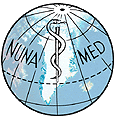Although most Inuit children in the Arctic are born healthy, there has been recognition of increased risk for a variety of diseases, congenital malformations, accidents as well as higher mortality as compared to non-Inuit. The causes of morbidity and mortality differ within age groups where for instance infants among the Inuit population in Canada have three times the risk of Sudden infant Dead Syndrome (SIDS) as compared to the general population in Canada. The Inuit infants in Canada and Denmark have an excess risk of congenital malformations, for instance gastroschisis, a congenital defect in the anterior abdominal wall through which the intestines protrude as compared to children in Denmark and Greenland.
The Alaskan Inuit children have higher prevalence of hospitalization due to lower-respiratory-tract infections; skin and soft tissue infections; and kidney, urinary tract, and bladder infections as compared to the US population in general. Children in Greenland have a very high prevalence of ear infections and tuberculosis. A recent study has shown that the Inuit children in Greenland had significantly higher glucose, total cholesterol, apolipoprotein A1 levels, and diastolic blood pressure indicating adverse metabolic heath profile as compared with Danish children which could indicate a tendencies toward higher prevalence of diabetes and metabolic morbidity in the Inuit children population. Further more, deaths due to accidents among children all ages in Greenland is much higher than in Denmark.
In this workshop the health disparities and challenges amongst Inuit and non-Inuit children in the Arctic will be outlined and discussed. We will have a discussion about the priorities as well as possible surveillance systems and strategies to collectively address children’s health in the Arctic.
Presentations are planned, but additional are welcome. Please contact Malene Børresen (mlb@ssi.dk).
Responsible for the workshop:
Malene Landbo Børresen (1,2), Sorcha Collins (3), and Laura Arbour (3).
1. Department of Epidemiology Research, Statens Serum Institut, Copenhagen, Denmark.
2. Department of Paediatrics, Herlev Hospital, Copenhagen, Denmark.
3. Department of Medical Genetics, University of British Columbia Island Medical Program, Victoria, Canada.

